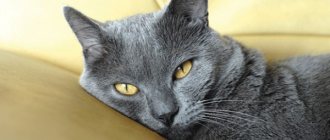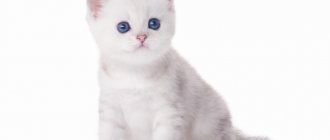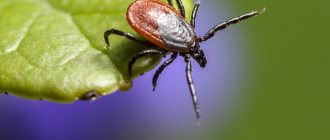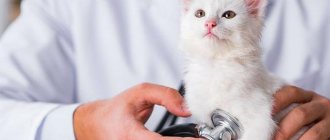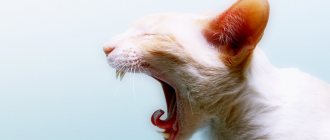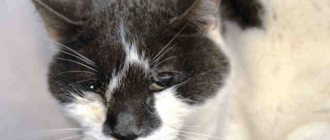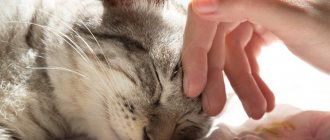Volvulus in cats is a fairly rare phenomenon and mainly occurs in dogs. However, it is an extremely dangerous condition and always leads to the death of the animal if timely assistance is not provided. This condition is a twisting of the mesentery, causing blockage of the artery supplying the intestines with blood.
After circulatory impairment, necrosis occurs, that is, tissue death. Subsequently, peritonitis occurs, then sepsis and the animal dies. Therefore, it is extremely important to have time to notice the first symptoms of this dangerous condition and have time to take the animal to a veterinary clinic for emergency care.
Scientists have not yet identified the exact causes of volvulus in cats.
However, some factors have been identified that contribute to the occurrence of this spontaneous phenomenon:
- — getting injured;
- — diseases of the gastrointestinal tract;
- - hormonal imbalance in the body;
- - too active and mobile state of the animal after eating.
What is intestinal blockage and why is it dangerous?
Intestinal obstruction in a cat (also known as blockage or obstruction) is the inability to pass or partially pass food through the digestive tract.
What is the danger
The intestines work without interruption, and even if there is a blockage, digestive juices and enzymes continue to be produced, and the intestinal walls continue to absorb the nutrients entering it. Digestive juice, having no outlet, accumulates, irritates the stomach and causes uncontrollable vomiting, which leads to rapid dehydration.
If there is an intestinal obstruction, you need to show the cat to a veterinarian
If the cause of obstruction is a foreign body, intussusception or volvulus, blood circulation is disrupted at the site of stagnation and the intestines immediately swell. Without treatment, swelling develops into inflammation and then into necrosis. Intoxication of the body develops over 1-2 days, so it is important to contact the clinic after the first symptoms.
Symptoms
Volvulus has a clear clinical picture and is manifested by severe pain. It is easy for a breeder to notice that not everything is fine with a pet. The cat is in pain and begins to meow loudly and pitifully, even scream.
The pet's behavior will also be unusual: the cat may scurry around in search of a comfortable place, attract attention, or vice versa, hide and hide from the owner. As a rule, there is no appetite, and the cat refuses to eat, even its favorite treats. This is due to the fact that after eating the state of health deteriorates sharply.
The abdominal wall is tense and sharply painful. Gas formation increases, the stomach swells, becomes hard, and the contents in the intestines rumble loudly. This can be determined by simply palpating the cat's belly.
Volvulus is manifested by frequent vomiting with blood and frequent urge to vomit. The cat does not allow you to touch its belly, it can show aggression, bite and scratch. The animal cannot go to the toilet for a long time and may roll on the floor to help pass gas, but to no avail. Due to stagnation in the intestines, intoxication develops, which is accompanied by an increase in body temperature and dehydration, due to which weight decreases sharply, the nose becomes dry, and the eyes become cloudy.
The most dangerous complication is pain shock and loss of consciousness. In a matter of minutes, the animal can die. You should seek help immediately, without wasting a minute. Do not treat symptoms on your own
, since taking laxatives and antiemetics can lead to serious complications, intestinal rupture and rapid death of the cat.
Causes of the disease
The most common cause of obstruction is a foreign body in the esophagus, intestines or stomach. This can also occur due to intestinal atony, a tumor in the gastrointestinal tract, helminthic infestation, hernia, intussusception or volvulus.
Foreign body in the intestine
Intestinal Obstruction in Cats: Symptoms and Treatment
Cats tend to eat small objects that they play with. Unfortunately, this happens quite often. Threads, Kinder toys, Legos - all this attracts the attention of tailed friends, and if eaten, can cause intestinal obstruction.
During play, the cat may swallow a foreign object.
Symptoms:
- Vomiting with increasing frequency. First, recently eaten food, possibly digested or partially digested. Further, the gag reflex remains, but there is nothing to come out of - the cat is vomiting stomach juice, bile, or the vomiting is empty.
- Decreased or lack of appetite.
- Lethargy, apathy, the cat is “lying like a rag.”
- Diarrhea, little or no stool.
- Noticeably enlarged abdomen, painful on palpation.
Attention! If in the middle of the night the cat suddenly begins to vomit uncontrollably within 10-15 minutes after each meal or water, you should not put off visiting the veterinarian until the morning, this could cost the pet’s life.
Volvulus in a cat, symptoms
Throughout the entire digestive tract, the intestines and stomach are attached to each other and to each other by a special ligament called the mesentery. The mesentery contains intestinal lymph nodes and blood vessels that participate in internal metabolism and supply the intestines with blood.
When this ligament is twisted, volvulus occurs and the intestine stops receiving nutrients. Ischemia of the intestinal area occurs, which develops in a matter of hours. At the site of the volvulus, swelling instantly forms, which over time develops into peritonitis (acute inflammation) of the abdominal cavity.
Fortunately, among domestic animals, cats are the least susceptible to volvulus, since their mesenteric ligaments are quite elastic. A healthy cat will not develop this condition suddenly.
At risk:
- older animals (13 years and older);
- cats with a history of gastrointestinal diseases;
- cats after intestinal surgery.
Factors that increase the risk of volvulus:
- active games immediately after feeding;
- gastrointestinal oncology;
- pathologies of the endocrinological system;
- foreign bodies in the intestines;
- advanced helminthic infestation;
- infectious diseases of the gastrointestinal tract (panleukopenia, coronovirus);
- early feeding after intestinal surgery.
Symptoms of intestinal volvulus:
- acute pain in the abdominal area, the cat does not allow himself to be picked up, screams;
- severe bloating;
- lack of feces;
- vomiting with blood or mucus;
- general dehydration of the body.
- decreased or lack of appetite.
If any of the listed symptoms, and even more so if there are several, you need to take your pet to the veterinarian as soon as possible.
Intussusception
Intussusception is the depression of a segment of the intestine into an adjacent segment due to the difference in the activity of its parts. The intestine instantly swells, and the cat experiences severe pain.
Intussusception is one of the causes of intestinal obstruction
Intussusception is not an independent disease. This is a symptom that occurs due to intestinal obstruction, intestinal atony or due to severe helminthic infestation. Signs of intussusception are similar to those of intestinal obstruction.
Intestinal parasites
The cause of intestinal obstruction may be severe helminthic infestation. This is especially common in small kittens that are picked up from the street: the new owner gives an anthelmintic in order to get rid of the uninvited guests, but the kitten suddenly becomes ill. The dead helminths rolled into a lump inside the intestines and closed its lumen.
This is an extremely dangerous condition, because this lump begins to secrete waste products directly into the intestines. Instant intoxication occurs, minutes count.
Pets need parasite treatment once every three months. The dosage is determined by weight. People are recommended to undergo treatment once every six months.
Symptoms of helminthic infestation:
- excessive thinness with normal or increased appetite;
- dull coat;
- general weakness, apathy;
- bloating. In the case of kittens, the small animal seems to look like a ball, despite the fact that its bones stick out and its skeleton is easily palpable;
- vomiting of semi-digested food; worms can be seen in the vomit - usually roundworms or tapeworms;
- diarrhea, feces with worms.
Cats need to be treated for worms to avoid intestinal obstruction
Attention! Medicines for cats are prescribed by a veterinarian, and for humans – by a therapist. Human deworming medications are strictly contraindicated for animals. They can lead to the death of the animal!
Neoplasms in the intestines
Cats older than 8-10 years are predisposed to neoplasms in the intestines; the risk increases from 7 years of age. Oncology still remains a mystery to scientists and no one can name the exact cause of its occurrence.
The most commonly developing gastrointestinal tumor in cats is lymphoma or lymphosarcoma. In the final stages, it may be the cause of intestinal obstruction.
The insidiousness of tumors lies in the fact that their development for a long time is asymptomatic. If a tumor is detected at an early stage, in most cases it can be completely removed, preserving the functionality of the gastrointestinal tract. But this can be done extremely rarely.
Symptoms:
- Vomiting with bile, mucus, blood.
- Severe cachexia (decreased muscle mass) with normal appetite.
- Vocalization (screaming) during defecation.
- Intestinal dysfunction for a long time. The cat has either diarrhea or prolonged constipation.
- Blood and mucus in the stool. If the neoplasm is localized in the small intestine, then the blood will be almost black, digested. With a tumor in the thick or straight section, the blood is scarlet.
- Lumps on the intestines that can be felt through the abdominal wall and visualized on ultrasound and x-ray.
Important ! The most effective method for diagnosing neoplasms is CT and MRI, which are performed on cats only under anesthesia.
Pylobezoar
A pylobezoar is a hard ball of rolled up fur that a cat swallows when it licks itself. Normally, hair is excreted from the body in feces, but if the hair ball is too large, then problems arise.
Long, fluffy hair can cause pilobezoar
The symptoms are the same as for a foreign body. Pilobezoar closes the intestinal lumen, but this condition can be prevented with prevention.
Coprostasis
Coprostasis (in other words, constipation) is a condition when feces cannot move normally through the intestines. Feces accumulate and cause intoxication. Coprostasis can lead to intestinal volvulus or rupture.
Causes of coprostasis:
- foreign body in the intestine;
- pylobezoar;
- gastrointestinal diseases - chronic inflammation, infections;
- diseases of the bile ducts;
- intestinal neoplasms;
- severe helminthic infestation;
- adhesions after surgery;
- insufficient amount of moisture in the diet.
Important! If your cat eats dry food, there should always be a bowl of fresh water available.
The main symptom of coprostasis is that the cat cannot go to the toilet for a long time. If feces come out, it is in very small portions. The cat may scream when trying to defecate.
Professional help
With intussusception, X-ray images show a clear picture of stretching of the small intestine. There may be liquid in the cavities. A specialist will not be able to tell the owners for sure that the pet has bloat; only surgery will give an accurate answer. Unfortunately, many mustachioed creatures die before they can reach the clinic with their owners.
If the pet was successfully delivered, then the animal will undergo surgery at the veterinary clinic - this is the only way to rid it of the problem.
During the operation, the specialist must carefully examine all parts of the intestine and give the twisted area a normal anatomical position. Tissues that have undergone necrosis will be removed.
If the lesion has affected most of the tissues, then complete removal of the small intestine is possible; in this case, the mustachioed creature will need maximum care, since it will need to be constantly taken to courses of maintenance therapy and its nutrition will be strictly monitored for the rest of its life.
Diagnostics in a veterinary clinic
Enteritis in cats: symptoms and treatment
Intestinal obstruction in cats, the symptoms and treatment of which should be determined by a doctor, is a disease that cannot be ignored. However, the best assistant in making a diagnosis is the animal owner. After all, only the owner can tell everything about his animal so that the doctor can make the right decision on how to diagnose and treat the disease.
The owners will have to meaningfully answer the doctor’s questions:
- how long ago did vomiting appear and how often does it happen;
- How has your cat’s appetite changed recently?
- how long ago the cat pooped, and what the poop was like;
- whether the cat tends to play with small objects and chew them.
It is also necessary to donate blood for biochemical and general clinical tests to assess the general condition of the body.
For diagnosis, the cat is given an x-ray with contrast.
If intestinal obstruction is suspected, the doctor will prescribe a number of tests:
- Ultrasound of the abdominal cavity.
- X-ray with contrast. Barium sulfate is used as a contrast. With its help, you can see the path of a bolus of food through the stomach. In addition, there are often cases when barium “envelops” a foreign body and is excreted in the feces. In these cases, surgery can be avoided.
- If all the symptoms indicate a foreign body, but it was not possible to see it using ultrasound and x-rays, a diagnostic autopsy (diagnostic laparotomy) is performed.
Prevention
First of all, prevention includes thorough cleaning of the apartment. All small objects, threads, needles, yarn and the like should be out of the cat's reach. It is impossible to predict what your pet will want to eat.
It is necessary to ensure that the cat does not swallow foreign objects.
What needs to be done for prevention:
- Thorough cleaning of the premises.
- If your cat tends to eat the litter, you should change it.
- Malt paste for hair removal.
- Regular brushing of fur.
- Scheduled medical examination every six months, which includes an ultrasound of the abdominal cavity, blood tests - biochemistry and general clinic, as well as an examination by a veterinarian.
- Scheduled deworming every three months.
- Routine vaccination once a year against viral diseases of cats, including panleukopenia.
- Organizing rest after eating.
Prevention is always easier and cheaper than treatment.
If clinical signs of intestinal obstruction appear, the best thing to do for your pet is to consult a doctor. Timely visit to the clinic increases the chances of recovery and significantly reduces the risk of complications.
Video
Treatment of intestinal obstruction in cats
Treatment is prescribed by a veterinarian based on the general condition of the cat and test results.
Toxoplasmosis in cats: symptoms and treatment
In case of partial obstruction, veterinarians prescribe the following treatment:
- A warm place at rest, sometimes cellular confinement for the duration of treatment.
- Intravenous infusions of nutritious saline solutions to eliminate intoxication and relieve dehydration, antibiotics, analgesics.
- Mild prokinetics to improve intestinal motility.
- Laxatives: Duphalac, vaseline oil inside, enemas with vaseline oil, Microlax enemas.
- A diet with a high fiber content in the form of soft food or puree;
- For obstruction caused by helminthic infestation, use anthelmintic drugs under the supervision of a physician.
With a confirmed diagnosis of “foreign body” and complete obstruction, surgery cannot be avoided. During the operation, the surgeon removes the foreign body and sometimes the affected area of the intestine. In rare cases, when a foreign body is stuck in the stomach or at the outlet of the stomach, it can be removed with a gastroscope.
In some cases, surgery under general anesthesia is required
After discharge, it is necessary to strictly follow the prescriptions: probiotics, antispasmodics, antibiotics for the prevention of sepsis, a specialized diet.
The postoperative period lasts 10-14 days, during which time it is wiser to leave the animal in the hospital’s hospital so that recovery takes place under the supervision of a doctor.
Intestinal obstruction in cats is an emergency condition. A cat can be adopted without tests, since waiting for results takes up precious time.
Important! Therapy at home is not possible and can only cause harm!
Symptoms
When torsion of the sigmoid colon occurs, the following manifestations are observed:
- There is a sharp cutting and stabbing pain in the lower abdomen. It radiates to the lower back and sacrum. It is constant in nature, less often cramping, occurs at the moment of intestinal volvulus and is associated with a violation of the blood supply.
- 2-3 times vomiting with bile, which does not improve the condition. With the onset of peritonitis, it may be mixed with feces (in later stages).
- At the time of volvulus, increased peristalsis is noted, followed by intestinal paresis, gases and feces cease to pass away.
- The abdomen is greatly distended and asymmetrical - the upper right sections protrude due to displacement of the sigmoid colon.
- Difficulty breathing and irregular heart rhythm: the volume of the transverse colon increases due to gases. The intestine puts pressure on the diaphragm, it moves upward, which in turn compresses the heart and lungs, their work is disrupted. Also, increased intra-abdominal pressure interferes with normal blood flow, which puts extra strain on the heart. Manifested by arrhythmia, tachycardia and chest pain.
In the subacute form, the symptoms are less pronounced.
With volvulus of the small intestine and cecum, the symptoms are similar. Initially, acute intense pain occurs, which increases, and it becomes difficult to endure. It can be either constant or cramping, has a stabbing or cutting character. Concentrated in the upper abdomen. The patient takes a lying position with his knees bent and pressed to his stomach, but this does not bring relief. The behavior is restless, patients may scream in pain or rush around the bed.
- The abdomen is swollen and asymmetrical, with a protrusion in the navel area;
- Intensified waves of peristalsis are visible on its surface, cramping pain and rumbling appear;
- Repeated vomiting, first with food and bile, and at a later stage with feces;
- Retention of feces and gases may not be observed, since peristalsis of the underlying parts of the colon is preserved. And if treatment is carried out in a timely manner, there will be no bowel dysfunction. If several hours have already passed from the onset of the disease, a symptom may develop.
- General intoxication of the patient and his serious condition.
Provoking factors
Veterinarians cannot name a definite reason why a cat develops this condition. But there are known factors that increase the risk of developing volvulus:
- the appearance of a malignant tumor in the digestive system or in organs located in the abdominal cavity;
- vigorous physical activity immediately after a heavy meal;
- mechanical impacts (compression, impact, bruise);
- endocrine disorders that cause increased elasticity of ligaments;
- entry and sticking of foreign bodies in the intestine;
- various gastrointestinal pathologies (tumors, infections, inflammations);
- helminthic infestations in advanced stages.
